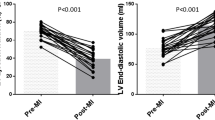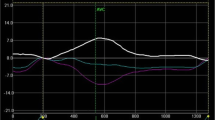Abstract
Quantitative analysis of left ventricular (LV) deformation based on two-dimensional speckle tracking echocardiography (2D STE) has increasingly been used to assess segmental and global function because conventional echocardiography is influenced by tethering effects of adjacent myocardium and cardiac translational motion. Hypothesis: (1) 2D STE can be useful to detect subtle regional changes in the LV contractility during development of tachycardia-induced cardiomyopathy (TIC) to heart failure in awake dog; (2) oxidized glutathione (GSSG) and reduced glutathione (GSH) levels are associated with the development of its respective segmental wall motion abnormalities (WMA). 6 healthy canine female Beagles were examined using 2D STE myocardial strain analysis before and for 8 weeks on week basis of rapid ventricular pacing (RVP) and at the end of study each myocardial segment were evaluated for oxidative status (GSH:GSSG ratio). 2D STE showed an initial peak of reduced global radial strain at 2 weeks of RVP in all three cardiac levels analyzed in which the affected segments showed a decreased transmural fiber shortening from anteroseptal to inferior segments distributed in helical pattern suggesting impaired contractility from part of left band to apical loop of spiral muscle band while global circumferential strain showed to be reduced since the fifth week of RVP particularly in the base and midventricular levels of ascending segment in clockwise direction from lateral to inferior segments. The most affected segments are localized in the lateral to posterior wall, however, segmental oxidative stress analysis did not show correlation with WMA detected by strain. 2D STE strain demonstrated to be a reliable tool for evaluation of LV myocardial deformation in TIC canine model showing an earlier significant WMA using radial strain and later using circumferential strain which may be of importance for improvement of diagnosis and therapy in naturally occurring canine cardiomyopathy and for earlier detection of WMA after suboptimal pacemaker lead placement.





Similar content being viewed by others
References
D’hooge J, Heimdal A, Jamal F, Kukulski T, Bijnens B, Rademakers F, Hatle L, Suetens P, Sutherland GR (2000) Regional strain and strain rate measurements by cardiac ultrasound: principles, implementation and limitations. Eur J Echocardiogr 1(3):154–170
Park HE, Chang S, Kim H, Shin D, Kim J, Seo M, Kim Y, Cho G, Sohn D, Oh B, Park Y (2010) Impact of loading condition on the 2D speckle tracking-derived left ventricular dyssynchrony index in nonischemic dilated cardiomyopathy. Circ Cardiovasc Imaging 3:272–281
Nakai H, Takeuchi M, Nishikage T, Lang RM, Otsuji Y (2009) Subclinical left ventricular dysfunction in asymptomatic diabetic patients assessed by two-dimensional speckle tracking echocardiography: correlation with diabetic duration. European Journal of Echocardiography 10:926–932
Sengupta SP, Caracciolo G, Thompson C, Abe H, Sengupta PP (2013) Early impairment of left ventricular function in patients with systemic hypertension: new insights with 2-dimensional speckle tracking echocardiography. Indian Heart J 65(1):48–52
Cho GY, Marwick TH, Kim HS, Kim MK, Hong KS, Oh DJ (2009) Global 2-dimensional strain as a new prognosticator in patients with heart failure. J Am Coll Cardiol 54(7):618–624
Choi EY, Rosen BD, Fernandes VR, Yan RT, Yoneyama K, Donekal S, Opdahl A, Almeida AL, Wu CO, Gomes AS, Bluemke DA, Lima JA (2013) Prognostic value of myocardial circumferential strain for incident heart failure and cardiovascular events in asymptomatic individuals: the multi-ethnic study of atherosclerosis. Eur Heart J 34(30):2354–2361
Suffoletto MS, Dohi K, Cannesson M, Saba S, Gorcsan J III (2006) Novel speckle-tracking radial strain from routine black-and-white echocardiographic images to quantify dyssynchrony and predict response to cardiac resynchronization therapy. Circulation 113(7):960–968
Shinbane JS, Wood MA, Jensen DN, Ellenbogen KA, Fitzpatrick AP, Scheinman MM (1997) Tachycardia-induced cardiomyopathy: a review of animal models and clinical studies. J Am Coll Cardiol 29(4):709–715
Ellis ER, Josephson ME (2013) Heart failure and tachycardia-induced cardiomyopathy. Curr Heart Fail Rep 10:296–306
Yücel D, Aydoğdu S, Cehreli S, Saydam G, Canatan H, Seneş M, Ciğdem Topkaya B, Nebioğlu S (1998) Increased oxidative stress in dilated cardiomyopathic heart failure. Clin Chem. 44(1):148–154
Damy T, Kirsch M, Khouzami L, Caramelle P, Le Corvoisier P, Roudot-Thoraval F, Dubois-Randé JL, Hittinger L, Pavoine C, Pecker F (2009) Glutathione deficiency in cardiac patients is related to the functional status and structural cardiac abnormalities. PLoS ONE 4(3):e4871
Cesselli D, Jakoniuk I, Barlucchi L, Beltrami AP, Hintze TH, Nadal-Ginard B, Kajstura J, Leri A, Anversa P (2001) Oxidative stress-mediated cardiac cell death is a major determinant of ventricular dysfunction and failure in dog dilated cardiomyopathy. Circ Res 89(3):279–286
Takimoto E, Kass DA (2007) Role of oxidative stress in cardiac hypertrophy and remodeling. Hypertension 49(2):241–248
Thomas WP, Gaber CE, Jacobs GJ, Kaplan PM, Lombard CW, Moise NS, Moses BL (1993) Echocardiography committee of the specialty of cardiology, american college of veterinary internal medicine. Recommendations for standards in transthoracic two dimensional echocardiography in the dog and cat. J Vet Intern Med 7(4):247–252
Bjørnstad K, Maehle J, Aakhus S, Torp HG, Hatle LK, Angelsen BA (1996) Evaluation of reference systems for quantitative wall motion analysis from three-dimensional endocardial surface reconstruction: an echocardiographic study in subjects with and without myocardial infarction. Am J Card Imaging 10(4):244–253
Rüssel IK, Götte MJ, Bronzwaer JG, Knaapen P, Paulus WJ, van Rossum AC (2009) Left ventricular torsion: an expanding role in the analysis of myocardial dysfunction. JACC Cardiovasc Imaging. 2(5):648–655
Rahman I, Kode A, Biswas SK (2006) Assay for quantitative determination of glutathione and glutathione disulfide levels using enzymatic recycling method. Nat Protoc 1(6):3159–3165
Buckberg G, Mahajan A, Saleh S, Hoffman JI, Coghlan C (2008) Structure and function relationships of the helical ventricular myocardial band. J Thorac Cardiovasc Surg 136(3):578–589
Gaitonde RS, Subbarao R, Michael MA, Dandamudi G, Bhakta D, Mahenthiran J, Das MK (2010) Segmental wall-motion abnormalities of the left ventricle predict arrhythmic events in patients with nonischemic cardiomyopathy. Heart Rhythm. 7(10):1390–1395
Fauchier L, Eder V, Casset-Senon D, Marie O, Babuty D, Cosnay P, Fauchier JP (2004) Segmental wall motion abnormalities in idiopathic dilated cardiomyopathy and their effect on prognosis. Am J Cardiol 93(12):1504–1509
Sweeney MO, Prinzen FW (2008) Ventricular pump function and pacing: physiological and clinical integration. Circ Arrhythm Electrophysiol. 1(2):127–139
Lieberman R, Padeletti L, Schreuder J, Jackson K, Michelucci A, Colella A, Eastman W, Valsecchi S, Hettrick DA (2006) Ventricular pacing lead location alters systemic hemodynamics and left ventricular function in patients with and without reduced ejection fraction. J Am Coll Cardiol 48(8):1634–1641
Thambo JB, Bordachar P, Garrigue S, Lafitte S, Sanders P, Reuter S, Girardot R, Crepin D, Reant P, Roudaut R, Jaïs P, Haïssaguerre M, Clementy J, Jimenez M (2004) Detrimental ventricular remodeling in patients with congenital complete heart block and chronic right ventricular apical pacing. Circulation 110(25):3766–3772
Torrent-Guasp F, Ballester M, Buckberg GD, Carreras F, Flotats A, Carrió I, Ferreira A, Samuels LE, Narula J (2001) Spatial orientation of the ventricular muscle band: physiologic contribution and surgical implications. J Thorac Cardiovasc Surg 122(2):389–392
de Simone G, Ganau A, Roman MJ, Devereux RB (1997) Relation of left ventricular longitudinal and circumferential shortening to ejection fraction in the presence or in the absence of mild hypertension. J Hypertens 15(9):1011–1017
Leitman M, Lysiansky M, Lysyansky P, Friedman Z, Tyomkin V, Fuchs T, Adam D, Krakover R, Vered Z (2010) J Circumferential and longitudinal strain in 3 myocardial layers in normal subjects and in patients with regional left ventricular dysfunction. Am Soc Echocardiogr. 23(1):64–70
Sengupta PP, Tajik AJ, Chandrasekaran K, Khandheria BK (2008) Twist mechanics of the left ventricle: principles and application. JACC Cardiovasc Imaging. 1(3):366–376
Park SJ, Miyazaki C, Bruce CJ, Ommen S, Miller FA, Oh JK (2008) Left ventricular torsion by two-dimensional speckle tracking echocardiography in patients with diastolic dysfunction and normal ejection fraction. J Am Soc Echocardiogr 21(10):1129–1137
Wang J, Khoury DS, Yue Y, Torre-Amione G, Nagueh SF (2008) Preserved left ventricular twist and circumferential deformation, but depressed longitudinal and radial deformation in patients with diastolic heart failure. Eur Heart J 29(10):1283–1289
Helm RH, Leclercq C, Faris OP, Ozturk C, McVeigh E, Lardo AC, Kass DA (2005) Cardiac dyssynchrony analysis using circumferential versus longitudinal strain: implications for assessing cardiac resynchronization. Circulation 111(21):2760–2767
Moe GW, Marin-Garcia J, Konig A, Goldenthal M, Lu X, Feng Q (2004) In vivo TNF-alpha inhibition ameliorates cardiac mitochondrial dysfunction, oxidative stress, and apoptosis in experimental heart failure. Am J Physiol Heart Circ Physiol 287(4):H1813–H1820
Meluzin J, Spinarova L, Hude P, Krejci J, Poloczkova H, Podrouzkova H, Pesl M, Orban M, Dusek L, Korinek J (2009) Left ventricular mechanics in idiopathic dilated cardiomyopathy: systolic-diastolic coupling and torsion. J Am Soc Echocardiogr 22(5):486–493
Bauer SF, Schwarz K, Rüegg JC (1989) Glutathione alters calcium responsiveness of cardiac skinned fibers. Basic Res Cardiol 84(6):591–596
Adamy C, Mulder P, Khouzami L, Andrieu-abadie N, Defer N, Candiani G, Pavoine C, Caramelle P, Souktani R, Le Corvoisier P, Perier M, Kirsch M, Damy T, Berdeaux A, Levade T, Thuillez C, Hittinger L, Pecker F (2007) Neutral sphingomyelinase inhibition participates to the benefits of N-acetylcysteine treatment in post-myocardial infarction failing heart rats. J Mol Cell Cardiol 43(3):344–353
Aikawa R, Komuro I, Yamazaki T, Zou Y, Kudoh S, Tanaka M, Shiojima I, Hiroi Y, Yazaki Y (1997) Oxidative stress activates extracellular signal-regulated kinases through Src and Ras in cultured cardiac myocytes of neonatal rats. J Clin Invest. 100(7):1813–1821
Ekelund UE, Harrison RW, Shokek O, Thakkar RN, Tunin RS, Senzaki H, Kass DA, Marbán E, Hare JM (1999) Intravenous allopurinol decreases myocardial oxygen consumption and increases mechanical efficiency in dogs with pacing-induced heart failure. Circ Res 85(5):437–445
Gage RM, Burns KV, Bank AJ (2014) Echocardiographic and clinical response to cardiac resynchronization therapy in heart failure patients with and without previous right ventricular pacing. Eur J Heart Fail 16(11):1199–1205
Liakopoulos OJ, Tomioka H, Buckberg GD, Tan Z, Hristov N, Trummer G (2006) Sequential deformation and physiological considerations in unipolar right or left ventricular pacing. Eur J Cardiothorac Surg 29:S188–S197
Delgado V, Tops LF, Trines SA, Zeppenfeld K, Marsan NA, Bertini M, Holman ER, Schalij MJ, Bax JJ (2009) Acute effects of right ventricular apical pacing on left ventricular synchrony and mechanics. Circ Arrhythm Electrophysiol. 2(2):135–145
Author information
Authors and Affiliations
Corresponding author
Ethics declarations
Conflict of interests
The authors declare no potential conflicts of interest with respect to the research, authorship, and/or publication of this article.
Rights and permissions
About this article
Cite this article
Nakata, T.M., Matsuura, N., Kaji, H. et al. Sequential radial and circumferential strain and oxidative stress assessment in dogs with tachycardia-induced cardiac dysfunction. Int J Cardiovasc Imaging 32, 583–591 (2016). https://doi.org/10.1007/s10554-015-0812-x
Received:
Accepted:
Published:
Issue Date:
DOI: https://doi.org/10.1007/s10554-015-0812-x




